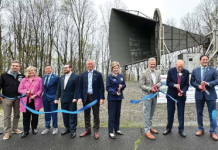
SEA BRIGHT — For 18 years there has been a constant in the borough as Maria Fernandes held forth in her different roles, on the Planning Board, Borough Council and then as mayor for four years. But with the installation of the new mayor, Fernandes is stepping back.
Last year, following a series of health problems, Fernandes, 59, decided not to seek re-election as mayor.
“When the time came for campaigning,” for the 2011 mayoral race, she explained in an interview with The Two River Times on Wednesday, “I said I would definitely run again. But then I thought maybe it’s time to hang my hat up and let someone else do it.”
That someone else, it turned out was fellow Democrat Dina Long, a borough council member, who was elected to the mayoral office in November.
Deciding to retire is bittersweet for Fernandes, who acknowledged she had come to really enjoy the nuts and bolts of government work and its final results, which is to help people and solve problems.
“I was doing things (based on) what was best for the borough,” she said.
Fernandes, who is from Elizabeth, moved to Sea Bright with her family back in 1958, when her parents bought their first of two Ocean Avenue properties. As an adult she worked for a steamship company in Newark, where she was in charge of its international shipping, and later worked as a middle manager for a Holmdel-based dental manufacturing company.
Her career in public service began back in 1994 when then-Mayor Charles Rooney asked her first to run for borough council (which she turned down at the time, thinking she had no taste for politics) and then to take a seat on the planning board. She found that she actually liked working on the board. “I always liked helping people and I wanted to explain the process,’ she said of her early days, noting she developed an appreciation for the work of architects and engineers in the process, as well. “You learned a lot of things,” she said.
She rarely missed board meetings and went to all of the borough council meetings. She then worked on the council campaign for Democratic candidate Elizabeth Smith. She eventually conceded to Rooney’s request to run for council, winning pretty decisively in 1996.
The major issue then was the sewer/sanitary system, as the governing body decided to enact a separate utility and a corresponding bill, much to the outrage of residents, she recalled.
As a council member upgrading the sewer system remained a top priority for her.
“I guess my mind was in the gutter,” she kidded. But stressed it was and is an important issue for the small beachfront community.
She lobbied local Assembly people and helped secure $1.5 million in state grants for the rehabilitation work on the system and pump stations. “That was very fulfilling,” she said of that accomplishment.
Later she helped usher in the Downtown Infrastructure Improvement Project, winning about $1 million in grant money, allowing the borough to repave and redo roadway and sidewalks on a number of side streets.
Recently, she had been working with U.S. Representative Frank Pallone Jr. (D-NJ) on getting Federal Emergency Management Agency (FEMA) funding to replace some bulkheading and pumping equipment to address the long standing flooding problem. “We’ve made very good headway,” she said.
“So, I guess I’m glad I had my head in the gutter,” she said.
“I was never political. I’m not political now,” she stressed. “I never had any political aspirations.” But in the aftermath of Rooney’s death, she charged, the borough council became so mired in partisan bickering it was at a stalemate.
“What always bothered me was the time wasted on politics.” So, she decided to run for mayor, winning the office.
“I think name recognition is good,” and may have contributed to her victory then. But more importantly for the voters, she suspected, “I was a working council member.”
Looking back on her time in office, Fernandes conceded that she would have like to have made greater strides in the per pupil cost borough property owners have been saddled with over the years to send local students out of district for schooling, long a bane to local taxpayers and officials (costing upwards of more than $90,000 per year, per student). “I wish we had the opportunity to sit down with the commissioner [of education] or the governor himself,” she said. “But we did make inroads.”
She has been responsive to the needs of her constituents, helping where she can or finding out where help can be obtained. “I am not shy about getting back to everybody,” she said.
Last year, Fernandes suffered a mild stroke, affecting her speech and movement on her right side. She also had her right leg amputated due to circulatory problems, which led to her decision to retire.
But it may not be the last voters hear from her, she hinted. “These challenges have a way of winding up in my lap,” she said, with a smile.
“I may look to come back to the council. You never know.”














